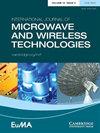A tunable balanced phase shifter with wide operating bandwidth
IF 1.3
4区 计算机科学
Q3 ENGINEERING, ELECTRICAL & ELECTRONIC
International Journal of Microwave and Wireless Technologies
Pub Date : 2023-11-03
DOI:10.1017/s1759078723001228
引用次数: 0
Abstract
Abstract A wideband tunable balanced phase shifter is achieved by utilizing varactor-loaded coupled lines (VLCLs)-embedded multistage branch-line structure. The tunable phase shift with low in-band phase deviation is attributed to the regulation in phase shift of the VLCLs and the horizontal microstrip lines in series. The wideband differential-mode (DM) impedance matching and common-mode (CM) suppression are due to multiple DM transmission poles and CM transmission zeros, which are brought about by the cascade of VLCLs and a microstrip line with short-circuited stubs in the DM-equivalent circuit and open-circuited stubs in the CM-equivalent circuit, respectively. Compared with the state-of-the-art tunable balanced phase shifters, the proposed design not only has the advantages of wide operating bandwidth (BW) with low in-band phase deviation but also has low insertion loss and easily fabricated structure. Theoretical analysis and design procedure were conducted, resulting in a prototype covering the frequency of 1.8 GHz. This prototype offers a tunable phase shift capability ranging from 0° to 90°. The prototype exhibits an operating BW of 45%, with a maximum phase deviation of ±6°. It also achieves a 10 dB DM return loss and CM suppression, while maintaining a maximum insertion loss of 2.5 dB.具有宽工作带宽的可调谐平衡移相器
摘要利用变容负载耦合线(vlcl)内嵌多级支路结构实现宽带可调谐平衡移相器。低带内相位偏差的可调相移是由于vlcl与水平微带线串联时相移的调节。宽带差模(DM)阻抗匹配和共模(CM)抑制是由于多个DM传输极和CM传输零,它们分别是由vlcl级联和DM等效电路中具有短路存根和CM等效电路中具有开路存根的微带线引起的。与现有的可调谐平衡移相器相比,该设计不仅具有宽工作带宽和低带内相位偏差的优点,而且具有低插入损耗和易于制作的结构。通过理论分析和设计程序,得到了覆盖1.8 GHz频率的样机。这个原型提供了一个可调的相移能力,范围从0°到90°。该样机的工作BW为45%,最大相位偏差为±6°。它还实现了10 dB的DM回波损耗和CM抑制,同时保持最大插入损耗为2.5 dB。
本文章由计算机程序翻译,如有差异,请以英文原文为准。
求助全文
约1分钟内获得全文
求助全文
来源期刊

International Journal of Microwave and Wireless Technologies
ENGINEERING, ELECTRICAL & ELECTRONIC-TELECOMMUNICATIONS
CiteScore
3.50
自引率
7.10%
发文量
130
审稿时长
6-12 weeks
期刊介绍:
The prime objective of the International Journal of Microwave and Wireless Technologies is to enhance the communication between microwave engineers throughout the world. It is therefore interdisciplinary and application oriented, providing a platform for the microwave industry. Coverage includes: applied electromagnetic field theory (antennas, transmission lines and waveguides), components (passive structures and semiconductor device technologies), analogue and mixed-signal circuits, systems, optical-microwave interactions, electromagnetic compatibility, industrial applications, biological effects and medical applications.
 求助内容:
求助内容: 应助结果提醒方式:
应助结果提醒方式:


